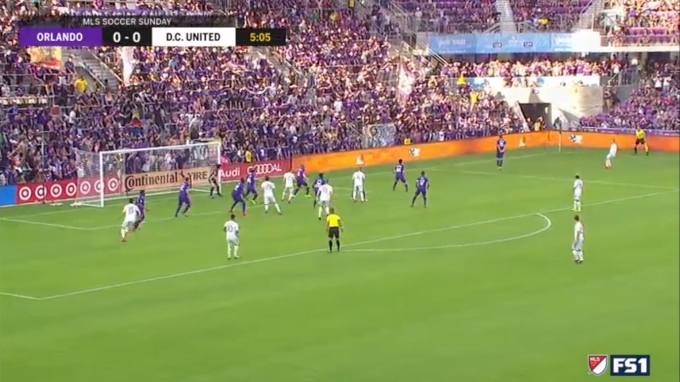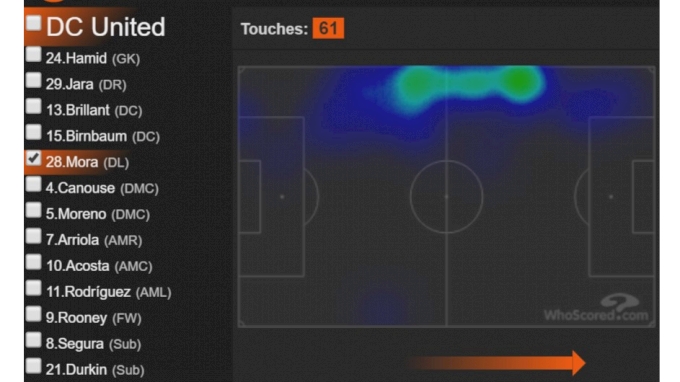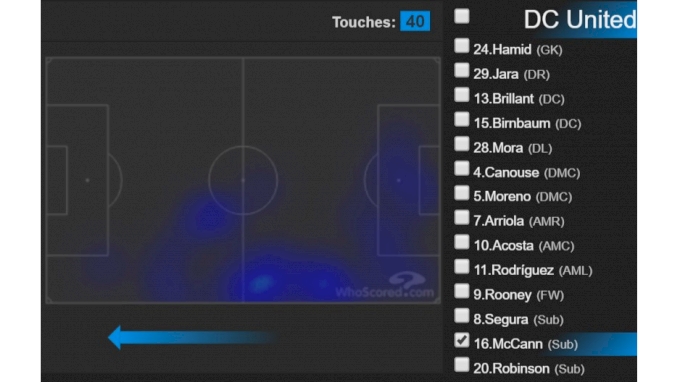How D.C. United Beat Orlando City By Sitting Deep In The Second Half
How D.C. United Beat Orlando City By Sitting Deep In The Second Half
Analyzing D.C. United's performance in the 2-1 win over Orlando City on Sunday night.

In Sunday night's 2-1 win over Orlando City, D.C. United took advantage of set pieces in the first half, and then they defended deep in the second half to pick up their third win in four games in 2019. There was a moment of brilliance in the first half from Wayne Rooney, who scored from a free kick near the sideline. Then there were some nervy moments in the second half when United had to gut out their win while the Lions applied an avalanche of pressure.
It didn't make for the sexiest win for United, but it was their first win on the road since May 2018. They had been winless for 11 games on their travels since that time, having made the playoffs last year despite a single win on the road. To get back to the playoffs and vie for a top spot in the Eastern Conference, United will have to pick up a couple more victories on the road in 2019.
Here we will break down how United left Orlando with all three points, and how United might have to make adjustments for the next month or so, with Joseph Mora now sidelined.
Set Piece, Set Pieces, Set Pieces
Thanks to two set-piece goals on Sunday night, United now have four set-piece goals in 2019. That doesn't count Rooney's penalty against Real Salt Lake, either. In the past couple of years, United have been missing a punch from set pieces in their repertoire, but that has all seemed to change with the arrival of Rooney.
Hunter already discussed Rooney's side of the set pieces from Sunday here. Go check that out if you haven't read it yet.
But on Steven Birnbaum's goal in the sixth minute, there was a bit of play design from United to get the center back in the position to score. On the broadcast, commentator Alexi Lalas said that it wasn't some elaborate plan to get Birnbaum open. That it was just Birnbaum wanting it more. And while the play might not have had the complexity of say a New York Red Bull routine, there was still some design in it.

This still is from just after Rooney has delivered the set piece. The five main targets in the box (this excludes Luciano Acosta, waiting near the top of the box next to the referee), all started just about in the middle of the box. Just before the delivery though, four of them made their way closer to the near post, while Birnbaum drifted backward behind his marker, Ruan.
Scoring from here took some cooperation from Ruan, who was ball watching and not paying attention to Birnbaum's positioning. But that is likely what United was banking on. Birnbaum moves behind Ruan, who quickly loses track of him. Birnbaum then steps in front without much resistance and heads home his first goal of the season. The space for him was opened up in part because of the movement towards the near post as well.
It still takes a good delivery to score, and that's the advantage of having someone like Rooney delivering the ball. United showed last season just how good they could be from open play. If they can add consistency with set pieces, they will be even more dangerous to opponents in 2019.
Defending Deep
The Black-and-Red have talked about — especially since the arrival of Rooney — wanting to keep more of the ball as a way to defeat opponents. That hasn't been the case for most of Olsen's tenure, but then again, he never had a player like Rooney that could help the team accomplish that.
United have been on the losing side of the possession battle in three of their four games this season, though. The only time they had more of the ball than their opponent is when RSL finished the game with nine men. It hasn't been an issue, of course, as United are still unbeaten to start the season, having allowed just one goal.
On Sunday, though, there was plenty of sweating out the result against Orlando. And while United on several occasions tried to break out of pressure with possession, they were mostly defending deep in their own half. Contrast that to the opening day win over Atlanta United. The difference between the two games was at Atlanta was at home, while the Orlando game was on the road. However, in both instances, United had a two-goal lead in the second half.
The map on the left shows where United's defensive actions — tackles, blocks, interceptions, clearances, and recoveries — came against Atlanta. The map on the right is from the game against Orlando.

As you can tell, against Orlando United sat further back than they normally do nowadays. Especially after Dom Dwyer scored, United's main focus was on preventing a second goal, and dropping deep to protect their box was how they accomplished that.
It made for some nervous moments, none more than when Chris Mueller hit the post in stoppage time. But it goes to show that United were reverting to some old habits when three points are on the line.
The purple triangles represent clearances from United, either by headers of kick the ball out. There were 51 such actions, the most in MLS this year. United tried to make it difficult for Orlando to get into the box, and they succeeded for the most part. That's what has made United successful defensively this year: limiting mistakes in front of goal, and making access to the box hard to come by.
Dwyer's goal was a rare breakdown for United, and Mueller's header was another one that United survived. LAFC will present a whole new set of challenges for the Black-and-Red on Saturday, but United's focus will remain on protecting their box in the face of danger.
Chris McCann vs Joseph Mora
Mora had to exit the game against Orlando after taking a knee to the face, fracturing his jaw and suffering a concussion in their process. It was a tough break for the Costa Rican left back, who has quietly been a very solid left back in MLS after taking a couple of months to get acclimated last year.
Mora will be out for at least a month. Against Orlando, Olsen simply inserted Chris McCann, who was signed in February, into the left back spot. Olsen was asked this week if McCann was going to be the option there for the foreseeable future, and while the head coach didn't commit, it sure seems likely.
But McCann is a different type of left back than Mora. Here's what Olsen had to say about the difference between the two earlier this week:
"He's a different profile than Joseph. In some ways that can alter us, making us better in some areas. And maybe we will need to change some of our positioning because of what he's not. He's a very good passer, experienced, great positioning. Doesn't have the flat out speed that Joseph Mora does. Joseph is a little younger, can run up and down that line all night long."
That speed difference and ability to get up and down the left flank bears out in the heat maps between the two players. Here's what Mora did on opening day in 90 minutes against Atlanta United.

In this graphic, United's defending the goal on the left, while attacking the one on the right. Mora spent most of his time near midfield, as United were able to press higher, and keep the left back more involved higher up the field.
Contrast that to McCann's 75 minutes on Sunday against Orlando. In this graphic, United are defending the goal on the right, attacking the goal on the left.

Clearly, McCann doesn't get as far forward or as often as Mora did against Atlanta. McCann also had to defend in the box more, which the game state dictated. But McCann does add a bigger physical presence to United's back line over Mora, with the Irish defender clocking in at over six feet tall.
As Olsen said, United will have to make some adjustments as to how they'll operate if McCann gets the start on Saturday against Los Angeles FC. Those adjustments might only be slight tweaks, but they will be necessary to account for the absence of Mora.